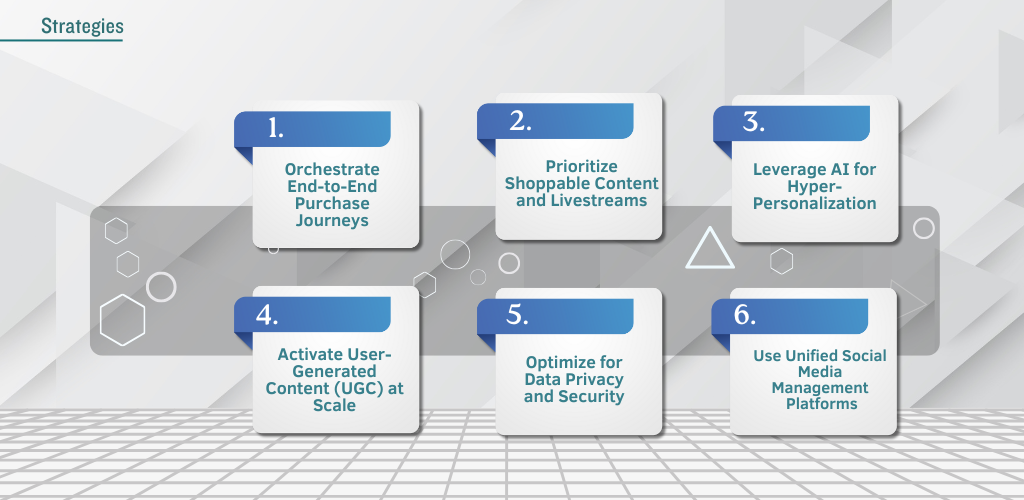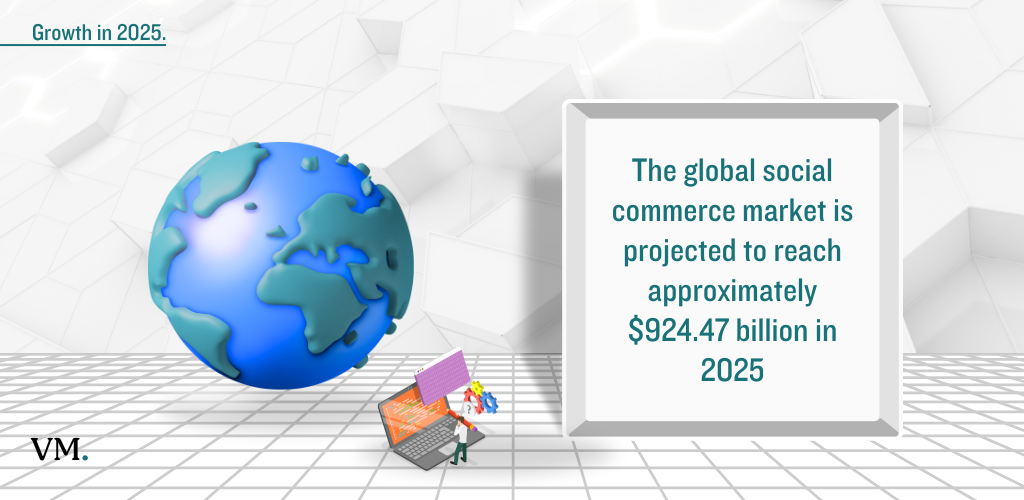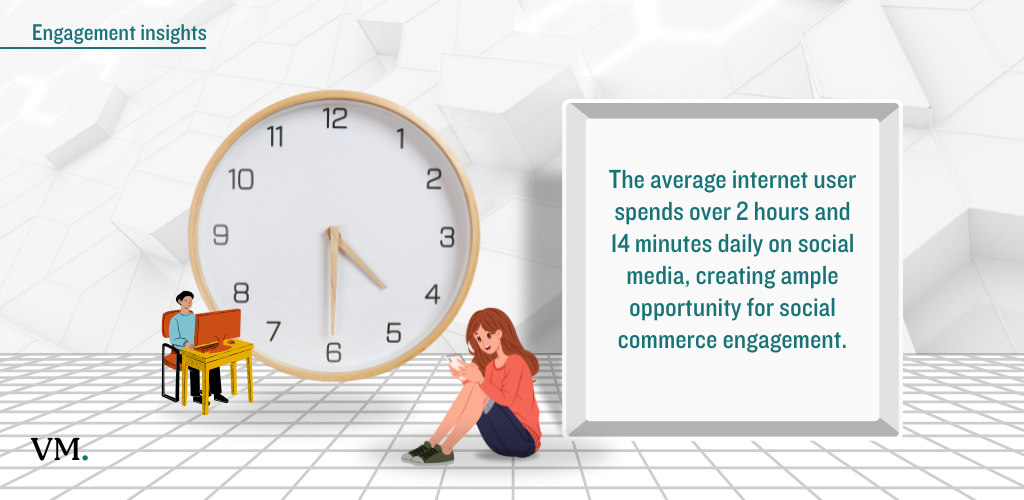Social commerce is now a core pillar of e-commerce and D2C growth. In 2025, the integration of social media and online retail is reshaping how products are discovered, evaluated, and purchased. This deep dive provides a detailed, actionable blueprint for brands and content creators to capitalize on social commerce’s current momentum.
Social Commerce in 2025: The Landscape
Social commerce merges the immediacy of social media with the convenience of e-commerce. Platforms like Instagram, TikTok, and Pinterest have evolved into transactional environments, allowing users to move from discovery to purchase without leaving the app.
By 2030, social commerce revenue is projected to reach $6.2 trillion, underscoring its explosive growth and strategic importance.
Key Actionable Strategies

- Orchestrate End-to-End Purchase Journeys
- Map the entire customer journey on social platforms: awareness, consideration, purchase, retention.
- Use targeted social ads, influencer partnerships, and visually compelling content to drive awareness.
- Deploy product demos, interactive guides, and user-generated content (UGC) for consideration.
- Implement shoppable posts, limited-time offers, and social proof (reviews, testimonials) at the purchase stage.
- Post-purchase, offer AI-driven customer service, retargeting ads, and exclusive loyalty content to retain customers.
- Prioritize Shoppable Content and Livestreams
- Integrate shoppable tags into posts, stories, and videos to reduce friction in the buying process.
- Host regular live-stream shopping events with influencers or brand representatives to demonstrate products, answer questions, and drive urgency.
- Use short-form, authentic video content—optimized for mobile—to showcase products in real-life contexts.
- Leverage AI for Hyper-Personalization
- Employ AI-powered tools to analyze user behavior and deliver personalized product recommendations, content, and offers in real-time.
- Use predictive analytics to segment audiences and automate dynamic content delivery, increasing relevance and conversion rates.
- Activate User-Generated Content (UGC) at Scale
- Encourage customers to share their experiences with branded hashtags and incentives.
- Curate and repurpose UGC as social proof across product pages, ads, and social feeds.
- Develop community-driven campaigns that spotlight real customer stories, increasing trust and engagement.
- Optimize for Data Privacy and Security
- Clearly communicate data collection and usage practices to build trust.
- Implement secure payment gateways and privacy-first personalization to address consumer concerns.
- Use Unified Social Media Management Platforms
- Centralize campaign management, analytics, and customer engagement with unified platforms to streamline operations and measure ROI.
- Automate routine tasks (posting, moderation, reporting) to free up resources for creative strategy and community building.
Implementation Checklist
| Strategy | Tactics | Tools/Platforms |
|---|---|---|
| End-to-End Purchase Journeys | Audience mapping, retargeting, AI chatbots | Sprinklr, Meta Commerce |
| Shoppable Content & Livestreams | Product tagging, live events, influencer collaborations | Instagram, TikTok, YouTube |
| AI Hyper-Personalization | Dynamic recommendations, automated segmentation | Shopify, Netcore, Emarsys |
| User-Generated Content Activation | Hashtag campaigns, UGC curation, community contests | Bazaarvoice, Yotpo |
| Data Privacy & Security | Transparent policies, secure payment, privacy-first personalization | Stripe, PayPal, Shopify |
| Unified Social Media Management | Centralized scheduling, analytics, and automation | Sprinklr, Hootsuite |
Metrics to Track
- Conversion rate from social platforms
- Engagement rate (likes, shares, comments, saves)
- Average order value from social channels
- UGC participation rate
- Customer retention and repeat purchase rates
- ROI on influencer/UGC campaigns
- Customer service response time (AI/chatbots)
Social Commerce by the Numbers — Key Statistics for 2025
Social commerce is rapidly transforming the retail landscape, with data in 2025 underscoring its scale, growth trajectory, and demographic drivers. This chapter presents critical statistics that quantify the opportunity and define the current state of social commerce globally and in key markets such as the U.S.
Market Size and Growth
-
The global social commerce market is projected to reach approximately $924.47 billion in 2025, growing at an annual rate of 11.8%. From 2021 to 2024, the market experienced a robust CAGR of 15.2%, with a forecasted CAGR of 10.0% from 2025 to 2030, potentially expanding to $1.48 trillion by 2030.
-
In the U.S., retail social commerce sales are expected to surpass $107 billion in 2025, representing about 7.2% of total U.S. e-commerce sales. The U.S. social commerce sector is growing at a CAGR of 24.7% through 2025.
-
Accenture projects global social commerce will triple traditional e-commerce growth rates, reaching $1.2 trillion by 2025. Social commerce currently accounts for 10% of all e-commerce globally and is expected to rise to 17% by 2025.

Consumer Adoption and Behavior
-
Approximately 31% of internet users worldwide are expected to engage in social shopping in 2025, with further growth anticipated beyond this year.
-
In the U.S., there are over 114 million social commerce buyers projected by 2025. The average annual spend per social commerce buyer in the U.S. is expected to reach $938, up from $641 in 2023, indicating a sustained growth rate above 20% year-over-year in spend per buyer.
-
Social media usage for product research is significant, with 82% of consumers using social platforms to research products. Among younger demographics, 55% of Gen Z prefer TikTok for shopping-related content, while 52% of Millennials favor Facebook.
-
Younger generations dominate social commerce spending: Millennials and Gen Z combined will account for 62% of global social commerce spend by 2025. Millennials alone will contribute approximately $401 billion, Gen Z about $359 billion, Gen X around $344 billion, and Boomers only $128 billion.
-
Nearly 64% of social media users globally have made a purchase via social commerce in the past year, translating to close to 2 billion social buyers worldwide.
Engagement and Platform Insights
-
The average internet user spends over 2 hours and 14 minutes daily on social media, creating ample opportunity for social commerce engagement.
-
Social commerce currently represents 6.6% of total U.S. e-commerce sales, with projections to grow steadily to over $150 billion by 2029.
-
About 7 in 10 U.S. businesses are actively selling products or services through social commerce platforms, signaling widespread adoption among retailers.

Summary
| Metric | Value (2025) |
|---|---|
| Global social commerce market size | $924.47 billion |
| Global CAGR (2021-2024) | 15.2% |
| Global CAGR (2025-2030 forecast) | 10.0% |
| U.S. social commerce sales | $107.17 billion |
| U.S. social commerce buyers | 114 million+ |
| Average U.S. spend per social commerce buyer | $938 |
| Social commerce % of total U.S. e-commerce sales | 7.2% |
| Percentage of social media users purchasing via social commerce | 64% (global) |
| Share of social commerce spending by Millennials and Gen Z | 62% |
| Daily average social media usage | 2 hours 14 minutes |
These statistics establish social commerce as a dominant and rapidly expanding retail channel, driven by younger consumers and enabled by evolving social platforms. Brands and content creators must leverage this data to tailor their strategies for maximum impact in 2025 and beyond.
Building a High-Conversion Social Commerce Funnel—Blueprint for 2025
A successful social commerce strategy in 2025 requires more than just presence on trending platforms. Brands must architect a conversion-focused funnel tailored to the realities of today’s social-first, mobile-native consumer. This chapter outlines a step-by-step blueprint for constructing a high-conversion social commerce funnel, emphasizing actionable tactics and operational detail.
1. Funnel Entry: Precision Targeting and Discovery
-
Audience Segmentation: Use platform-native analytics and third-party data tools to define granular audience segments based on interests, behaviors, and previous interactions.
-
Ad Creative Optimization: Develop short-form video ads and story content tailored to each segment. Use A/B testing to refine messaging and creative assets weekly.
-
Influencer Micro-Targeting: Partner with micro-influencers who have high engagement rates within your niche. Require influencers to use platform shoppable features, not just generic links.
2. Engagement: Interactive Content and Social Proof
-
Shoppable Video and Livestreams: Schedule weekly live shopping events with real-time Q&A, product demos, and limited-time offers. Use platform-native shopping tags for seamless checkout.
-
User-Generated Content Integration: Curate customer reviews, unboxing videos, and testimonials. Feature UGC in both paid and organic social placements.
-
Gamified Engagement: Deploy interactive polls, quizzes, and challenges that reward participation with exclusive offers or early product access.
3. Conversion: Seamless Checkout and Personalization
-
In-App Checkout: Enable one-click purchasing directly within social platforms. Integrate with payment providers that support autofill and digital wallets.
-
Personalized Product Recommendations: Use AI to serve dynamic product suggestions based on browsing and engagement history.
-
Urgency and Scarcity Tactics: Highlight low stock, limited-time discounts, and countdown timers in shoppable posts and stories.
4. Post-Purchase: Retention and Advocacy
-
Automated Follow-Up: Trigger post-purchase thank-you messages, order updates, and personalized product care tips via DMs or in-app notifications.
-
Loyalty and Referral Programs: Incentivize repeat purchases and referrals with exclusive rewards, early access, or bonus content delivered through social channels.
-
Community-Building: Create private groups or channels for customers to share experiences, provide feedback, and access VIP content.
5. Measurement: Analytics and Iteration
-
Funnel Analytics: Track each funnel stage—impressions, engagement, add-to-cart, purchase, repeat purchase—using platform analytics and third-party tools.
-
Attribution Modeling: Implement multi-touch attribution to understand which content and channels drive the highest conversion.
-
Continuous Optimization: Set a monthly review cadence to audit funnel performance, identify drop-off points, and deploy rapid tests for improvement.
Example Funnel Metrics Table
| Funnel Stage | Key Metrics | Tools/Platforms |
|---|---|---|
| Discovery | Impressions, CTR, Follower Growth | Meta Ads, TikTok Ads |
| Engagement | Video Views, Comments, Shares | Instagram, TikTok, Yotpo |
| Conversion | Add-to-Cart, Purchases, AOV | Shopify, Stripe |
| Retention | Repeat Purchases, Referral Rate | LoyaltyLion, Smile.io |
| Advocacy | UGC Volume, Community Growth | Facebook Groups, Discord |
Brands that implement a rigorous, data-driven social commerce funnel—optimized for discovery, engagement, conversion, and retention—will outperform competitors relying on ad hoc tactics. In 2025, the winners in social commerce are those who treat every stage of the funnel as a measurable, optimizable asset, leveraging platform-native features and real-time analytics to drive sustainable growth.
Wrap It Up
Social commerce in 2025 demands a rigorous, data-driven approach. Brands and content creators must orchestrate seamless purchase journeys, prioritize shoppable and interactive content, leverage AI for personalization, and activate UGC at scale. The brands that operationalize these strategies, backed by robust analytics and unified platforms, will capture the next wave of e-commerce growth.



